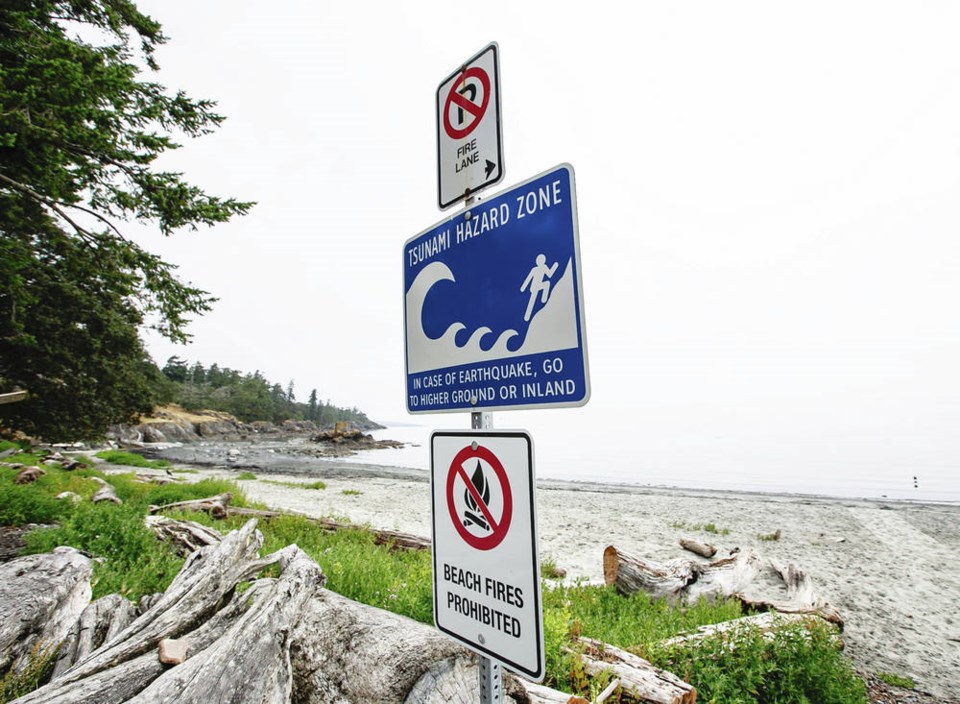On Monday afternoon, a 7.6-magnitude earthquake hit near Sand Point, Alaska, just before 2 p.m., triggering a tsunami warning for parts of the state and prompting questions about whether B.C. was at risk.
Shortly before 4 p.m. that day, the province was notified by the U.S. National Tsunami Warning Center in Alaska that there was no threat of tsunami to B.C.’s coastline. At 4:09 p.m., Emergency Info B.C. posted on Twitter: “No tsunami threat to B.C.”
If there had been a risk to the province, west coasters would have had about two hours to react before waves would have been expected.
For Islanders, damaging tsunami waves from an earthquake in Alaska would take about four hours to hit the Island, says an earthquake expert at the University of Victoria.
Tsunami waves travel over deep ocean at about the same speed as a jumbo jet, so how long they take to reach B.C. shores depends on where an earthquake strikes, said Ed Nissen, an associate professor and Canada Research Chair in the school of earth and ocean sciences at the University of Victoria.
The most northern stretch of B.C.’s coastline would be hit around 2.5 hours after a quake near Alaska, and Haida Gwaii would feel the effects after about three hours, according to data by the U.S. National Oceanic and Atmospheric Administration.
Officials in the U.S. tsunami warning centre would have spent the hours after the quake determining what type of earthquake they were dealing with, Nissen said.
The shaking Monday turned out to be a result of a strike-slip quake, where tectonic plates move horizontally. These types of earthquakes are unlikely to cause a tsunami, he said. The tsunami warning was likely lifted by officials once they determined that it had been a strike-slip earthquake, but it takes some time to complete calculations to figure out what mechanism caused the shaking, Nissen said.
A tsunami can occur after a thrust earthquake, when plates move vertically over top of each other, raising the sea floor. These are more common around B.C.’s coast.
The Island is in a subduction zone, and if an earthquake hit closer to home, it would take a matter of minutes for tsunami waves to reach the Island’s west coast, Nissen said. Victoria and Vancouver would probably have an hour or two before the waves travelled around the Island to reach the urban centres.
“And so if you’re by the coast, and you feel an earthquake, immediately go to higher ground. That’s the rule number one for tsunami risk reduction,” Nissen said.
Monday’s quake actually sent a “very small” tsunami to B.C.’s coast, but waves were so small it couldn’t have been observed by the naked eye, he said.
Sensitive instruments off the coast monitored by Ocean Networks Canada picked up small pressure waves Monday afternoon.
The U.S. Tsunami National Warning Center monitors and evaluates the risk of tsunami for the west coast of North America, from Alaska to California and including B.C. The centre communicates tsunami risks to B.C., which are then disseminated to municipalities and communities to activate emergency alerts. Local alerting systems vary by jurisdiction.
Emergency Management B.C. says anyone concerned about tsunami risk should inform themselves of their local government’s alerting processes.
People can also follow Emergency Info B.C. on Twitter or check the website emergencyinfobc.gov.bc.ca in the event of an earthquake, which will pass along verified information sent by the National Tsunami Warning Centre.
Because earthquakes and tsunamis don’t respect international borders, seismic activity needs to be monitored on a global scale, Nissen said.
“We need global monitoring systems, and we need agencies to work across borders, and they do that actually very effectively,” he said.
The quake in Alaska should serve as a reminder to Islanders that they live in an earthquake zone, and it’s important to practise “drop, cover and hold on” drills and prepare emergency kits with food, water and supplies, Nissen said.
“We know there will be an earthquake. The only question is when it happens.”
A tsunami warning was issued to Islanders in January 2018 after a powerful early-morning earthquake near Alaska. Local governments mobilized their alerting systems, which ranged from warning sirens in Tofino, Port Alberni and Tahsis, where risk was greater, to dispatching firefighters in Sooke to answer questions from worried residents.
For more information on how to prepare for a tsunami and what to do during an emergency, read the province’s tsunami guide online.



